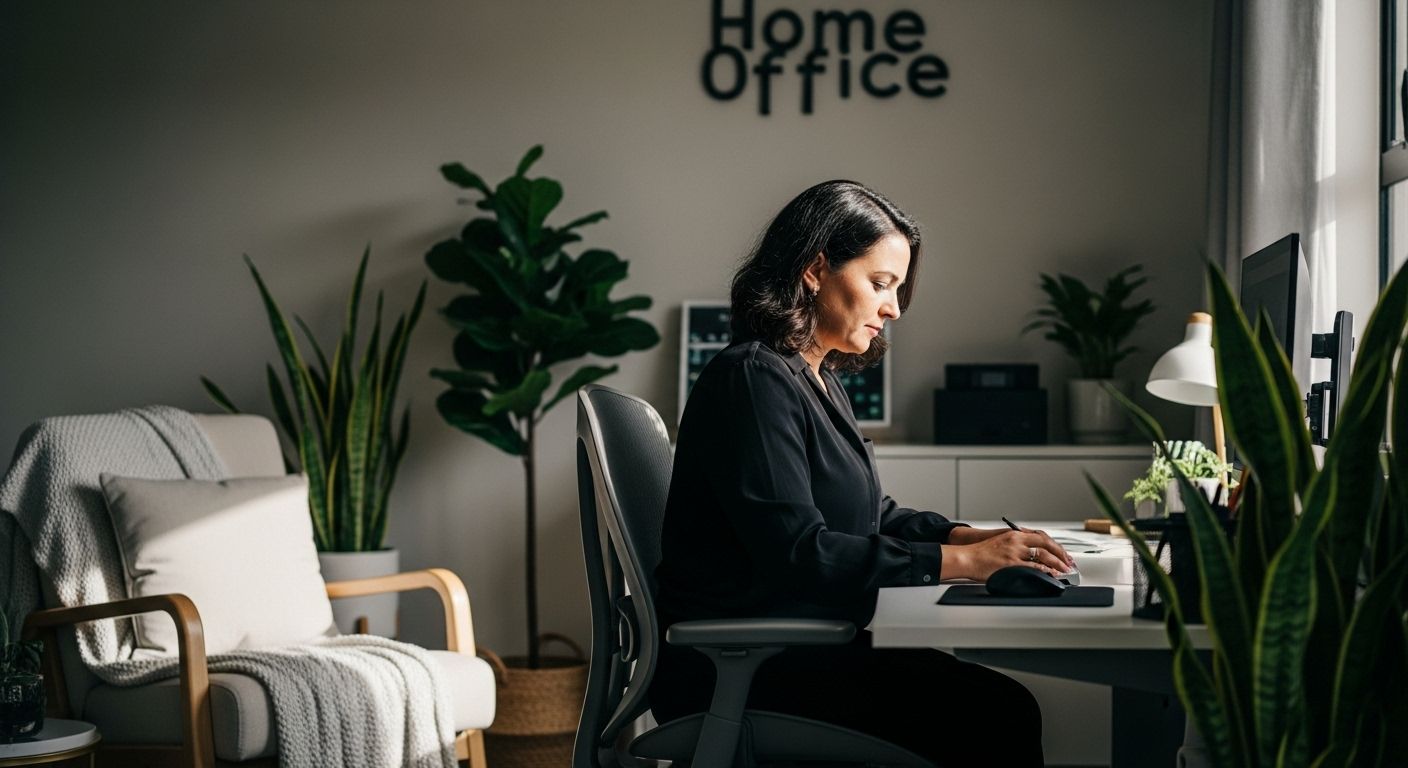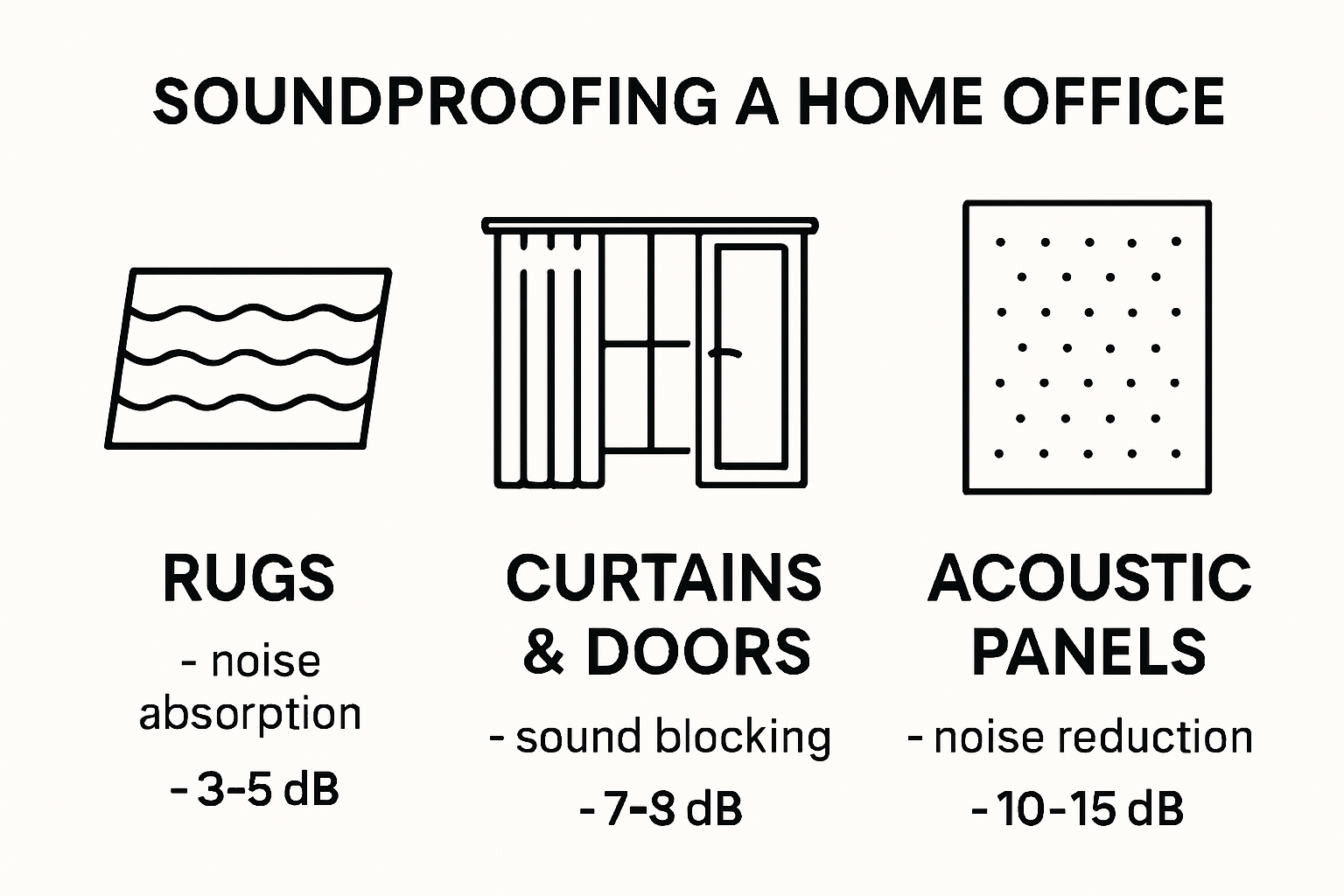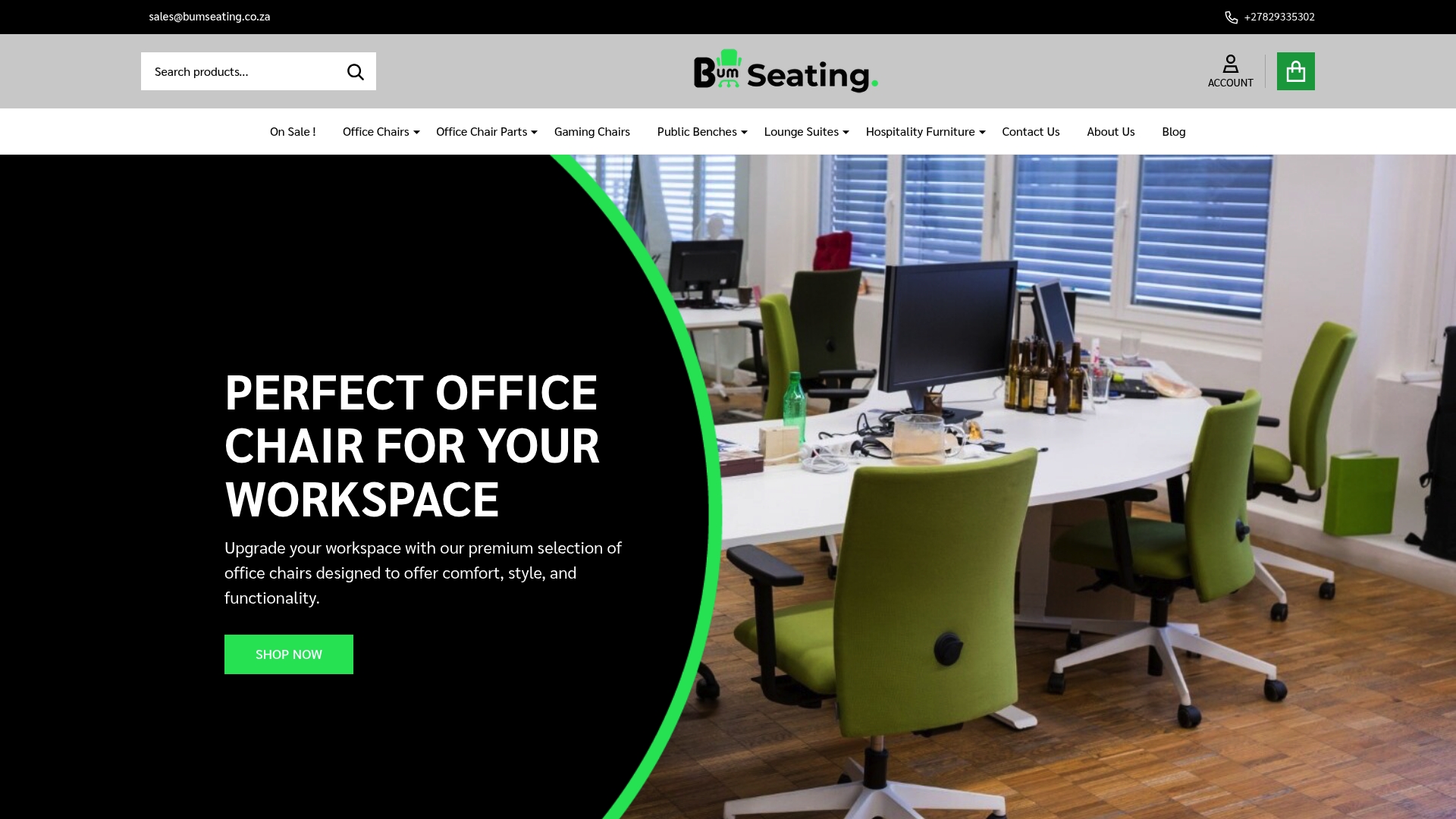Quiet Home Office Solutions for South African Workspaces 2025
4th Aug 2025
Quiet Home Office Solutions for South African Workspaces 2025

Quiet home offices used to feel like wishful thinking, especially with city traffic or loud neighbours making concentration nearly impossible. Yet, studies show that up to 50% of noise pollution can be cut even with your windows open using new smart tech. Most people think fancy headphones are the only answer, but your furniture and a few clever design tweaks often make a much bigger difference. You might be surprised where the real hush comes from.
Table of Contents
- Essential Furniture Choices For A Quiet Office
- Soundproofing Tips For South African Spaces
- Smart Technology To Reduce Home Office Noise
- Designing Productive And Calm Work Environments
Quick Summary
| Takeaway | Explanation |
|---|---|
| Choose acoustic furniture for noise reduction | Select high-backed chairs and movable panels to create sound barriers in your workspace. |
| Incorporate ergonomic design for comfort | Use adjustable chairs and desks to support body alignment and enhance mental clarity, minimizing distractions. |
| Utilize smart technology for noise management | Implement devices that monitor and control noise levels, allowing for a customized acoustic environment. |
| Apply soundproofing techniques in your home | Use thick rugs, curtains, and weatherstripping to effectively reduce noise coming from outside your workspace. |
| Personalize your workspace for improved focus | Add elements that reflect your style and support tranquility, such as plants or soothing lighting for a calming atmosphere. |
Essential Furniture Choices for a Quiet Office
Creating a quiet home office requires strategic furniture selection that goes beyond aesthetics. Bum Seating understands that the right furniture can transform your workspace into a sanctuary of productivity and tranquility. The key lies in choosing pieces that not only support your physical comfort but also help minimize distractions and create acoustic barriers.
Acoustic Furniture Design for Sound Reduction
Modern office furniture has evolved to address noise challenges directly. Research analyzing seating preferences in hybrid workplaces reveals that furniture design significantly impacts work concentration and stress levels. High-backed chairs with sound-absorbing materials, movable acoustic panels, and strategically placed dividers can create natural sound buffers within your home workspace.
Ergonomic chairs with high backs provide more than just physical support. They create a psychological barrier against external noise, helping workers maintain focus. Bum Seating offers designs that incorporate sound-dampening fabrics and contoured shapes that naturally block peripheral sounds. The goal is to create a personal acoustic environment that shields you from household disruptions.
Flexible Furniture for Personalized Workspace Management
A study examining faculty office spaces demonstrated that personalization is crucial for workplace satisfaction. Modular furniture solutions allow south-african professionals to adapt their workspace according to individual noise management needs. Portable screens, adjustable desk dividers, and compact workstations enable users to create temporary sound barriers or reconfigure spaces quickly.
Bum Seating recommends considering furniture with built-in flexibility. Chairs with wheels, lightweight partitions, and compact storage solutions allow for rapid workspace transformation. This adaptability is particularly valuable in home offices where space is often limited and multifunctionality is key.
Ergonomic Considerations for Comfort and Concentration
Ergonomic research analyzing furniture design highlights the critical connection between physical comfort and cognitive performance. Furniture that supports proper body alignment reduces physical strain, indirectly contributing to a more peaceful work environment. Chairs with adjustable lumbar support, height-adaptive mechanisms, and breathable materials help minimize physical discomfort that can become a source of distraction.
Bum Seating’s range of ergonomic chairs is designed with south-african professionals in mind. By prioritizing individual body mechanics and providing customizable support, these chairs help create a workspace where physical comfort translates into mental clarity and reduced stress.
Ready to transform your home office into a quiet, productive sanctuary? Explore Bum Seating’s ergonomic solutions and discover furniture that works as hard as you do. Your perfect workspace is just a click away.
To help you compare different types of furniture solutions mentioned for a quieter workspace, here’s a table summarizing their features, benefits, and adaptability:
| Furniture Solution | Key Features | Noise Reduction Benefit | Adaptability/Notes |
|---|---|---|---|
| High-backed ergonomic chair | High back, sound-dampening fabric, ergonomic | Creates sound buffers, psychological noise barrier | Provides physical and mental comfort |
| Movable acoustic panels | Portable, customizable, sound-absorbing | Natural sound buffer, reduces reverberation | Can be repositioned as needed |
| Modular/flexible desks | Adjustable height, compact, modular designs | Enables workspace reconfiguration, minimal sound | Adapts to various tasks/spaces |
| Portable screens/dividers | Lightweight, easy to move, customizable | Temporary sound barriers, separates work zones | Useful in multi-use spaces |
| Upholstered/soft furnishings | Dense weave, soft textures, sound-absorbing | Minimizes acoustic reflection, absorbs sound waves | Adds aesthetic value & comfort |
Soundproofing Tips for South African Spaces

Home offices in south-african urban and suburban environments face unique acoustic challenges. Noise from nearby traffic, construction, neighborhood activities, and shared living spaces can significantly disrupt work concentration. Bum Seating recognizes that effective soundproofing goes beyond simple solutions, requiring a strategic and multi-layered approach tailored to local living conditions.
Strategic Sound Absorption Techniques
Official CDC guidelines on noise control highlight the importance of comprehensive soundproofing strategies. In south-african home office settings, this means implementing multiple sound-dampening techniques. Soft furnishings play a crucial role in sound absorption. Thick area rugs, heavy curtains, and upholstered furniture can reduce sound reflection and minimize acoustic reverberation.
Textile-based interventions are particularly effective. Consider adding fabric wall hangings, acoustic panels wrapped in decorative materials, and strategically placed cushions. These elements not only absorb sound waves but also contribute to the aesthetic appeal of your workspace. Bum Seating recommends selecting materials with dense weaves and soft textures to maximize sound absorption.
Structural Soundproofing Solutions
Addressing structural elements can dramatically reduce noise transmission. Weatherstripping around doors and windows creates an immediate sound barrier, blocking external noise from entering your workspace. Draft stoppers and door seals are affordable interventions that provide significant acoustic benefits. For south-african homes with older construction or less-insulated spaces, these solutions are particularly valuable.
Consider investing in solid-core doors, which provide superior sound isolation compared to standard hollow doors. If complete door replacement is not feasible, acoustic door curtains or removable soundproofing panels can offer temporary yet effective noise reduction. Bum Seating suggests consulting local acoustic specialists who understand the specific sound challenges in different south-african urban and suburban environments.
Advanced Acoustic Technology and Design
Modern acoustic technologies offer sophisticated soundproofing solutions. White noise machines, noise-cancelling headphones, and desktop sound masking devices can create controlled acoustic environments. These technologies work by introducing neutral sound frequencies that help neutralize disruptive background noises.
Architectural design can also play a strategic role. Bookshelves positioned as room dividers, indoor plants with dense foliage, and carefully placed furniture can create natural sound barriers. The key is to create multiple layers of sound absorption and deflection. Experiment with furniture placement to maximize acoustic comfort without compromising workspace functionality.
Ready to create a peaceful, productive home office environment? Explore Bum Seating’s range of sound-friendly furniture solutions and transform your workspace into a sanctuary of concentration and comfort.
Here’s a table outlining the various soundproofing techniques mentioned, their purposes, and typical areas of application for south-african home offices:
| Soundproofing Method | Purpose | Typical Application Areas | Notes/Advantages |
|---|---|---|---|
| Thick rugs/soft furnishings | Absorb sound, reduce reflection | Floors, lounge, under desks | Easy to change, enhances comfort |
| Heavy curtains/fabric wall hangings | Dampen outside noise, minimize reverberation | Windows, walls | Dual aesthetic and acoustic effect |
| Weatherstripping/seals/draft stoppers | Block external noise | Doors, windows | Affordable, quick install |
| Solid-core doors | Isolate sound | Room entries, passageways | Higher cost, excellent isolation |
| Portable acoustic panels/dividers | Absorb/deflect sound, flexible placement | Any workspace area | Reposition as needed |
| White noise/sound masking devices | Mask disturbances, create neutral field | On desk, near entry points | Electronic, easy setup |
| Bookshelves/indoor plants | Deflect/absorb sound, natural buffer | As partitions or decor | Multipurpose, effective for open layouts |
Smart Technology to Reduce Home Office Noise
As south-african professionals increasingly embrace remote work, smart technology emerges as a powerful solution for managing acoustic challenges in home office environments. Bum Seating recognizes that technological innovations offer sophisticated noise reduction strategies beyond traditional soundproofing methods.
Advanced Noise Monitoring and Control Devices
Research published in the Journal of Occupational and Environmental Hygiene demonstrates the remarkable potential of smart devices in noise management. Modern smartphones and dedicated noise monitoring applications can now accurately measure and analyze acoustic environments, providing real-time insights into sound levels and potential disruptions.
Smart noise control devices leverage advanced algorithms to detect and neutralize background sounds. These intelligent systems can automatically adjust volume levels, activate noise-cancelling mechanisms, and create personalized acoustic environments. For south-african professionals working in diverse home settings, such technologies offer unprecedented control over workspace acoustics.
Wireless Active Noise Cancellation Technologies
Cutting-edge research on wireless noise control technologies reveals exciting developments in Active Noise Control (ANC) systems. These sophisticated technologies go beyond traditional noise-cancelling headphones, offering integrated solutions for entire workspaces. ANC-enabled devices can now create localized sound zones, effectively blocking unwanted noise while maintaining clear communication channels.
Bum Seating recommends exploring wireless ANC technologies that can be seamlessly integrated into home office environments. From smart window installations to adaptive headsets, these solutions provide flexible noise management options. The key advantage lies in their ability to create personalized acoustic environments that adapt to changing work conditions.
Innovative Architectural Noise Reduction Solutions
Researchers at Nanyang Technological University have developed groundbreaking technologies that can reduce noise pollution by up to 50%, even with open windows. These innovations represent a significant leap in architectural acoustic management, offering south-african professionals unprecedented control over their home office soundscapes.
Smart window technologies, acoustic panels with embedded sensors, and intelligent sound-filtering systems are transforming home office design. These solutions go beyond passive noise reduction, actively monitoring and adjusting acoustic environments in real-time. Bum Seating encourages professionals to view noise management as an integrated approach that combines furniture design, technological innovation, and strategic workspace planning.
Ready to revolutionize your home office acoustic experience? Explore Bum Seating’s smart workspace solutions and discover how technology can create your ideal work environment. Your perfect, noise-free workspace is just a click away.
Designing Productive and Calm Work Environments
Creating a productive and calm home office environment requires more than aesthetic considerations. Bum Seating understands that workspace design directly influences mental well-being, concentration, and overall professional performance. A thoughtfully designed workspace can transform your home office into a sanctuary of productivity and tranquility.
Holistic Environmental Management
The Centers for Disease Control and Prevention guidelines emphasize the critical relationship between workspace design and professional performance. South-african professionals must consider multiple environmental factors that contribute to a calm and focused work atmosphere. This involves strategic management of visual, acoustic, and thermal elements that collectively shape your work experience.
Lighting plays a crucial role in creating a calm workspace. Natural light sources should be maximized, complemented by adjustable artificial lighting that reduces eye strain. Position your workspace near windows when possible, using light-filtering curtains to control brightness and minimize glare. Soft, warm lighting can create a sense of comfort, while task-specific lighting ensures optimal visibility for detailed work.
Ergonomic Design and Mental Clarity
Research in environmental health demonstrates that indoor environmental quality significantly impacts productivity and stress levels. Bum Seating recommends an ergonomic approach that prioritizes both physical comfort and psychological well-being. Choose furniture that supports natural body alignment, reduces physical strain, and creates a sense of personal space.
Consider creating distinct zones within your home office. A dedicated work area separated from relaxation spaces helps maintain mental boundaries. Use room dividers, strategically placed furniture, or visual cues to define these zones. This psychological separation helps transition between work and personal life, a critical aspect of maintaining calm and focus in a home environment.
Personalization and Sensory Harmony
Personalization is key to creating a calm workspace. Incorporate elements that resonate with your personal aesthetic and professional identity. Select artwork, plants, or decorative items that inspire calm and creativity. Natural elements like indoor plants, wooden textures, and soft color palettes can create a sense of tranquility and connection to the environment.
Air quality and temperature also play significant roles in workspace design. Ensure proper ventilation, maintain comfortable temperature levels, and consider using air purifiers or plants that naturally filter air. These subtle environmental adjustments can dramatically improve concentration and reduce stress. Bum Seating suggests creating a workspace that feels like a personal retreat, balancing professional functionality with personal comfort.
Ready to transform your home office into a productive sanctuary? Explore Bum Seating’s comprehensive workspace solutions and discover how thoughtful design can elevate your professional experience. Your ideal work environment is waiting.
Frequently Asked Questions
What types of furniture can help reduce noise in a home office?
Choosing acoustic furniture such as high-backed chairs, movable acoustic panels, and ergonomic desks can effectively create sound barriers in your workspace, minimizing distractions and enhancing focus.
How can I soundproof my home office effectively?
Implementing multi-layered soundproofing techniques such as using thick rugs, heavy curtains, and weatherstripping around doors and windows can help significantly reduce external noise and improve your concentration.
Are there specific ergonomic considerations for creating a quiet workspace?
Yes, selecting chairs with adjustable lumbar support, height-adaptive mechanisms, and breathable materials can enhance comfort and support proper body alignment, leading to reduced distractions and improved focus during work hours.
What smart technologies can help manage noise levels in a home office?
Smart technologies like noise monitoring and control devices, wireless active noise cancellation technologies, and architectural noise reduction solutions can actively adjust and optimize the acoustic environment of your workspace.
Transform Your Home Office Into a True Sanctuary of Calm
Struggling with noise and distractions in your work-from-home setup has never been more common. The article above unpacked how urban noise, uncomfortable seating, and poor soundproofing can wreck your concentration. If you have had enough of city sounds breaking your flow or your chair leaving you sore, you deserve a solution that goes beyond makeshift fixes. Imagine reclaiming control with modern, ergonomic seating and clever workspace accessories that tackle both comfort and quiet head-on.

This is your chance to design a space that actually helps you work better. Explore our range of ergonomic office chairs and workspace solutions designed for South African homes just like yours. Enjoy detailed product info, clear pricing, fast delivery, and deals tailored to help you upgrade right now. The best workdays are waiting. Visit https://bumseating.co.za today and discover how easy it is to create your quiet, professional retreat at home.
